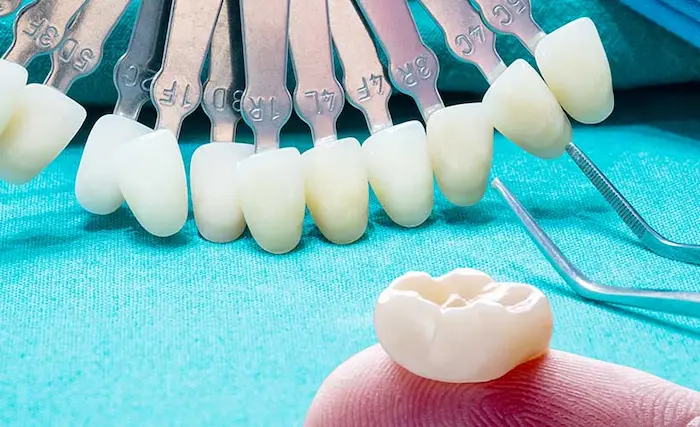
Zirconium crowns have become a popular option in modern dentistry, known for their combination of aesthetics and durability. However, when compared to other types of dental crowns on the market, zirconium crowns exhibit distinct differences. In this article, we will delve into the fundamental differences between zirconium dental crowns and other popular dental crown methods such as laminate crowns, porcelain dental crowns, metal crowns, and composite dental crowns. We will examine how zirconium crowns serve as an alternative in terms of each crown type’s advantages and disadvantages, cost, aesthetic appearance, durability, and application process.
Differences Between Zirconium Dental Crowns and Laminate crowns
Zirconium dental crowns and laminate crowns are two different methods frequently chosen in aesthetic dentistry, each with its unique advantages and disadvantages.
Zirconium crowns stand out for their high durability and strength, making them ideal for back teeth exposed to heavy chewing forces. In contrast, laminate crowns, which are thin porcelain sheets used to improve the aesthetic appearance of front teeth, are very successful in mimicking the natural appearance of teeth.
The cost of zirconium crowns is generally higher than that of laminate crowns due to the complexity of the production process and the material costs. However, the durability of zirconium suggests it could be a more economical option in the long run as it requires less maintenance and replacement.
Laminate crowns offer a less invasive application since they require the removal of less tooth material, which is an important consideration for some patients. However, laminate crowns’ fragility and lower resistance to impact compared to zirconium can affect their lifespan.
Ultimately, the choice of crown type depends on factors such as the patient’s aesthetic expectations, the functional requirements of the teeth, and budget. Both methods offer valuable solutions in modern dentistry, with zirconium crowns excelling in general durability and functionality, while laminate crowns stand out for their natural appearance and aesthetics.
Differences Between Zirconium Crowns and Porcelain Dental crowns
Zirconium crowns and porcelain dental crowns are popular dental restoration methods used to enhance aesthetics and functionality. Both offer unique advantages, but there are significant differences between them.
Zirconium crowns are made from a highly durable material, zirconium dioxide, and are especially suitable for back teeth that withstand heavy chewing forces. Porcelain crowns, on the other hand, are considered superior in providing a more natural look and are preferred mainly for front teeth.
In terms of cost, zirconium crowns are usually more expensive than porcelain crowns due to the material’s cost and the more complex processing required. However, the long lifespan and low maintenance needs of zirconium crowns can balance the initially higher cost over time.
Durability-wise, zirconium is superior to porcelain. Zirconium crowns are more resistant to breaking and cracking, maintaining their form even under extreme forces, which is a significant advantage for patients with issues like teeth grinding.
Another advantage of zirconium crowns is their biocompatibility, meaning they are well tolerated by the body and have a very low risk of allergic reaction. Although porcelain crowns are generally biocompatible, the biocompatibility of zirconium is particularly important for sensitive patients.
Differences Between Zirconium Dental Crowns and Metal Crowns
Zirconium dental crowns and metal crowns are two different material types used in dental restorations, each offering distinct advantages and application areas. One of the biggest advantages of zirconium is its ability to provide an aesthetic close to natural tooth color while also displaying excellent durability and strength. These features make zirconium crowns a popular choice, especially for front teeth seeking an aesthetic appearance.
Metal crowns, typically made from gold, silver, or other metal alloys, offer high durability and are chosen for back teeth exposed to high chewing forces. The greatest advantage of metal crowns is their extreme durability, able to maintain their form even after long-term use.
Price-wise, zirconium crowns are generally more expensive than metal crowns due to the complexity of processing zirconium and the material’s cost. However, the aesthetic advantages and biocompatibility of zirconium crowns justify their higher price.
In terms of durability, both types of crowns perform well, though metal crowns might be slightly superior against extreme forces. Nevertheless, the high strength of zirconium crowns ensures they provide adequate durability in most situations.
In recent years, with the increase in patients’ aesthetic expectations, zirconium crowns have become more preferred for visible teeth than metal crowns. The metallic color of metal crowns can be a source of aesthetic concern for some patients. On the other hand, zirconium crowns, not containing metal, can be a more suitable option for patients with metal allergies.
Differences Between Zirconium Crown and Composite Dental Crown
Zirconium crowns and composite dental crowns are two different material types used for dental restoration and aesthetic improvements. Zirconium crowns, made from the highly durable and aesthetically pleasing zirconium dioxide material, contrast with composite crowns, which are created from a resin-based compound offering a quicker and more economical solution.
Zirconium crowns are considered superior in terms of strength and durability compared to composite crowns. Therefore, zirconium crowns are particularly chosen for back teeth that are subjected to heavy chewing forces and situations requiring long-term durability. On the other hand, composite crowns are generally used for front teeth or small restorations subjected to less force. The ease of application and speed make composite material an ideal option for minor aesthetic dental corrections.
From a cost perspective, composite crowns are usually more economical than zirconium crowns. This is due to the lower cost of the composite material and the less complex application process. However, the long lifespan and superior aesthetic features offered by zirconium crowns can amortize their initially higher cost over the long term.
Zirconium crowns are preferred by patients seeking a more natural look and requiring high durability, while composite crowns serve as a suitable alternative for those looking for quicker and cost-effective solutions.
Moreover, zirconium crowns provide health advantages due to their biocompatibility and suitability for patients with metal allergies. Composite crowns, when applied correctly, can achieve an aesthetic very similar to natural tooth structure but may undergo color changes over time and require repolishing or replacement.
If you are looking for an expert team for zirconium crowns Istanbul, Alyans Clinic, our dental clinic in Kadıköy, is at your service with its expert dentists.


